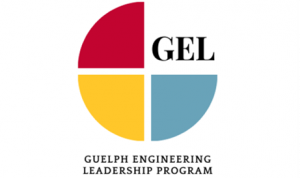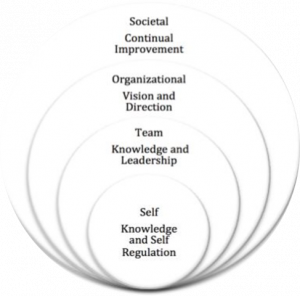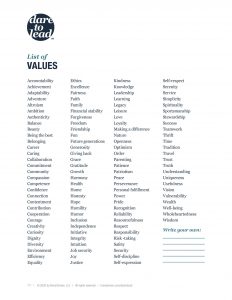3 Workshop 3: Organizational Leadership
Tiana Bressan; John Donald; and Technical Editor: Yasamin Jahani Kia

INTRODUCTION
We recognize that engineering is a leadership profession.
In GEL Workshop 1, we delved into self-leadership with a focus on personal values and life balance. In GEL Workshop 2, we discussed team dynamics and conflict resolution. Now, we are in the third leadership domain, Organizational Leadership, which involves vision and direction. Self-leadership was about leading yourself and your personal values, and organizational leadership is exactly that but on a much larger scale.

Jamieson, M., & Donald, J. (2020). Building the Engineering Mindset: Developing Leadership and Management Competencies in the Engineering Curriculum
What does this mean for us as students? Maybe you have had job interviews, or maybe you are just starting to apply and go through the process. The focus of this workshop is to ensure our work is fulfilling and aligning with our life’s purpose. When we seek jobs or when jobs ask us, “Why do you want to work for us?”, we want to be aligned with our vision and direction so that we can contribute our full potential.
LEARNING OBJECTIVES
Following this workshop, students will be able to:
This workshop will be split into three main parts:
- Mission statements: What do we do today?
- Vision statements: What are we striving for?
- Value statements: What do we stand for?
ORGANIZATIONAL LEADERSHIP
 This is a double helix of leadership and it is another model that emphasizes the intertwined work of delivering on organizational responsibilities and developing yourself personally to lead organizations effectively.
This is a double helix of leadership and it is another model that emphasizes the intertwined work of delivering on organizational responsibilities and developing yourself personally to lead organizations effectively.- Adaptability.
- Collaboration & community.
- Effective communication.
- Trust.
- Time management.
Tokar, S. (January, 2020). “What is organizational leadership?”. Southern New Hampshire University. Retrieved from: https://www.snhu.edu/about-us/newsroom/business/what-is-organizational-leadership.
Moe, K. (January, 2021). “ https://www.betterup.com/blog/what-is-organizational-leadership-and-why-is-it-important
MISSION STATEMENTS
What is a mission statement?
A mission statement outlines what the organization does, how it does it, and who it does it for. Companies have mission statements to communicate their purpose and overall intentions. It also acts as a “North Star” for an organization as it provides the direction that is to be followed. As we develop our organizational leadership, we need to know how to communicate our purpose, our goals, and our direction to others.
ACTIVITY 1: MISSION STATEMENTS
In this activity, you will choose 3 engineering or technology companies and find their mission statements. The worksheet for activity 1 can be found here.
REFLECTION
What would YOU include in a mission statement to encompass your life and aspirations? Think about the what, how, and who.
ACTIVITY 1: KEY TAKEAWAYS
Now that you have completed Activity 1 and evaluated some mission statements, you can observe the relevance of mission statements in interviews and when applying to various jobs. On a foundational, smaller-scale, we now have a lens to reflect on our own purpose and goals and on the larger organizational level, we can see how this purpose aligns, or does not with much larger scale goals of companies.
VISION STATEMENTS
Following the theme of defining mission statements, we are going to look at vision statements in connection to organizations and organizational leadership.
What is a vision statement?
Unlike a mission statement, which describes the who, what, and how of a business or organization, a vision statement describes the desired long-term results. A vision statement is meant to be future-based, inspirational, aspirational, and should challenge employees.
Our vision is a world where infrastructure creates opportunity for everyone– uplifting communities, improving access and sustaining our planet. We bring together the best people, ideas and technical expertise and partner with clients to turn their ambitions into action
VALUE STATEMENTS
We may often use personal values and value statements interchangeably but in reality it is a comparison between the small-scale personal values and the larger scale organizational values.
For example, personal values help us make sounder decisions and guide our actions. They are also what we consider to be important or the things that matter to our well-being and happiness. On the other hand, company value statements are the basis on which companies make decisions and companies often seek to align their culture with these values.
You might want to consider how your values might be reflected in company values.
Tim Horton’s core values include “make a difference, customer first, personal excellence, cooperation, and stewardship.”
Integrity, honesty, and respect.
In GEL workshops, we often talk about aligning your life with your values. You can take a moment now to note down some of the values that you might find important or emphasized in your life. You could also consider noting the values that you search for in companies.
Here is a list of values from the book “Dare to Lead” by Brené Brown: 
ACTIVITY 2: VISION & VALUE STATEMENTS
The worksheet for activity 2 can be found here.
Before we get into Activity 2, let’s review the concepts covered thus far.
Organizational Leadership: Organizational leadership communicates the mission and vision, establishes a strategic plan, and inspires individuals to put forth their talents to fulfill the goals aligned with the strategic plan and, ultimately, the leader’s vision.
Mission Statement: What is our purpose? WHAT do we do? HOW do we do it? WHO is it for?
Vision Statement: The goal to be reached.
Value Statement: Values and priorities of the company.
Now, select a founder of a company that grew their company from grassroots and complete the questions below.
What is the name of the Engineering/Technology company?
Who is the company founder?
What is the company’s mission?
What is the company’s vision?
What are some of the company’s values? [~2-3 values]
- Value 1
- Value 2
- Value 3
Brief Background of the company [~3-4 Bullet Points]:
- Why did this company begin?
Organizational Leadership:
- How was the founder an organizational leader? What skills do you need to successfully be an organizational leader?
- Why is organizational leadership relevant in engineering?
- What skills can help us as engineers develop as organizational leaders?
REFLECTION
Would YOU work in this company? Why or why not?
ACTIVITY 2: KEY TAKEAWAYS
As we strive to be socio-technological engineers, we realize that no matter what organization we are working for, we need to be able to communicate our vision to others and take this approach in every position we hold whether that’s being an intern or the CEO.
When we think about a vision, we need to consider how we can improve it and how we can inspire others around us to want to support that vision, both as students and as future engineers.
WORKSHOP KEY TAKEAWAYS
Moving forward, when we are looking for a job or company, it is important to understand YOUR mission, vision, and values to determine if the company aligns with them. This gives you a lens through which you can research a company and use it to your advantage during job interviews while allowing you to reflect on company culture.
RESOURCES
Click here to access the workshop worksheets.

